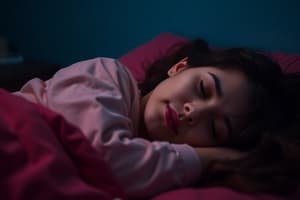Podcast
Questions and Answers
What is the main reason short-acting hypnotics are useful for achieving sleep?
What is the main reason short-acting hypnotics are useful for achieving sleep?
- They allow patients to awaken early in the morning without lingering side effects (correct)
- They increase the duration of sleep cycles
- They can be used as anxiolytics
- They induce REM sleep within minutes
What is the classification of barbiturates under the Controlled Substances Act?
What is the classification of barbiturates under the Controlled Substances Act?
- Schedule II for short-acting, Schedule III for intermediate-acting, and Schedule IV for long-acting (correct)
- Schedule IV for short-acting and Schedule III for long-acting
- Schedule I for short-acting and Schedule IV for long-acting
- Schedule III for short-acting and Schedule II for long-acting
What is the term for residual drowsiness experienced after taking a hypnotic?
What is the term for residual drowsiness experienced after taking a hypnotic?
- Dependence
- Hangover (correct)
- Rebound
- Sedation
What is the purpose of monitoring vital signs in patients taking short-acting barbiturates?
What is the purpose of monitoring vital signs in patients taking short-acting barbiturates?
What is the term for vivid dreams and nightmares that occur after taking a hypnotic?
What is the term for vivid dreams and nightmares that occur after taking a hypnotic?
What is the primary use of secobarbital?
What is the primary use of secobarbital?
How do the liver and body handle barbiturates?
How do the liver and body handle barbiturates?
What is the intermediate-acting barbiturate used for sustaining long periods of sleep?
What is the intermediate-acting barbiturate used for sustaining long periods of sleep?
What is the primary mechanism of action of melatonin agonists?
What is the primary mechanism of action of melatonin agonists?
What is a potential risk associated with taking CNS depressants with nonbenzodiazepine hypnotics?
What is a potential risk associated with taking CNS depressants with nonbenzodiazepine hypnotics?
What is the primary purpose of assessing baseline vital signs and laboratory tests in patients taking sedative-hypnotics?
What is the primary purpose of assessing baseline vital signs and laboratory tests in patients taking sedative-hypnotics?
What is a common adverse effect of ramelteon?
What is a common adverse effect of ramelteon?
What is the primary purpose of anesthetics?
What is the primary purpose of anesthetics?
What is a potential risk associated with taking sedative-hypnotics for several days?
What is a potential risk associated with taking sedative-hypnotics for several days?
What is the half-life of ramelteon?
What is the half-life of ramelteon?
What is the primary purpose of assessing a patient's sleep disturbance?
What is the primary purpose of assessing a patient's sleep disturbance?
Which stage of sleep do children experience the least?
Which stage of sleep do children experience the least?
What is the mildest form of CNS depression?
What is the mildest form of CNS depression?
High doses of sedative-hypnotics can suppress which part of the brain leading to respiratory depression?
High doses of sedative-hypnotics can suppress which part of the brain leading to respiratory depression?
Which of these drugs is categorized under anorexiants?
Which of these drugs is categorized under anorexiants?
What common side effect can result from taking barbiturates, although it is rare?
What common side effect can result from taking barbiturates, although it is rare?
Why are barbiturates less frequently prescribed now?
Why are barbiturates less frequently prescribed now?
Flashcards are hidden until you start studying
Study Notes
Barbiturates
- Classified under the Controlled Substances Act: Schedule II for short-acting, Schedule III for intermediate-acting, and Schedule IV for long-acting hypnotics
- Long-acting group includes Phenobarbital and Mephobarbital, used to control seizures in epilepsy
- Intermediate-acting barbiturates, such as Butabarbital, are useful as sleep sustainers for maintaining long periods of sleep
Side Effects and Adverse Reactions
- Hangover: residual drowsiness, impaired reaction time due to lingering active metabolites in the body
- REM Rebound: vivid dreams and nightmares, occurs after taking a hypnotic, especially after prolonged use and abrupt stopping
Pharmacokinetics
- Liver bio transforms hypnotics into active metabolites that persist in the body, causing drowsiness
Nursing Process: Patient-Centered Care
- Assess baseline vital signs and laboratory tests for future comparisons
- Obtain a drug history, especially CNS depressants with nonbenzodiazepine hypnotics that can depress respirations
- Ascertain the patient’s problem with sleep disturbance
Melatonin Agonists
- Act by selectively targeting melatonin receptors to regulate circadian rhythms in the treatment of insomnia
- Ramelteon: has a half-life of 1 to 2.6 hours, with adverse effects including drowsiness, dizziness, fatigue, headache, nausea, and suicidal ideation
Anesthetics
- Classified as general and local, depress the CNS, alleviate pain, and cause a loss of consciousness
- First anesthetic, nitrous oxide (“laughing gas”), was used for surgery in the early 1800s
Children and Older Adults Sleep Cycle
- Children: few REM sleep periods, longer periods of stage 3 and 4 NREM sleep
- Older adults: decrease in stage 3 and 4 NREM sleep, frequent waking periods
Sedative-Hypnotics
- Treatment of sleep disorders
- High doses can suppress the respiratory center in the medulla, causing respiratory depression
- Hypersensitivity: skin rashes and urticaria can result from taking barbiturates
Studying That Suits You
Use AI to generate personalized quizzes and flashcards to suit your learning preferences.




